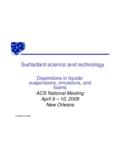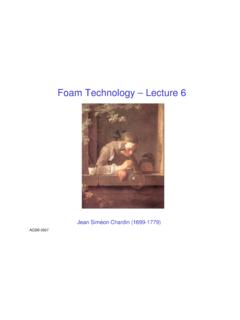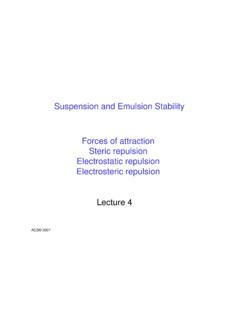Transcription of Lecture 6 Emulsion technology - Colloidal Dispersions
1 Ian Morrison 2008 Emulsion TechnologyDispersions in liquids: suspensions, emulsions, and foamsACS National MeetingApril 9 10, 2008 New OrleansLecture 6 - Emulsion technologyIan Morrison 2008 Typical food emulsionsFoodEmulsion typeDispersed phaseContinuous phaseStabilization factors, , creamO/WButterfat triglycerides partiallycrystalline and liquid size: 1 10 mVolume fraction: Milk: 3-4%Cream: 10- 30%Aqueous solution of milkproteins, salts, minerals, membrane, phospolipids,and adsorbed creamO/W(aeratedtofoam)Butterfat (cream) or vegetable,partially crystallized fraction of air phase: 50%Water and ice crystals, milkproteins, carboxydrates(sucrose, corn syrup)Approx. 85% of the watercontent is frozen at foam structure is stabilized byagglomerated fat globules formingthe surface of air surfactants act as destabilizers controlling fatagglomeration.
2 Semisolid : milk proteins,phospholipids, fraction: 16%Butterfat triglycerides,partially crystallized andliquid oils; genuine milkfat globules are droplets distributed in semi-solid, plastic continuous fat (to be aerated)O/WVegetable oils and size: 1 5 fraction: 10 30%Aqueous solution of proteins(casein), sucrose, salts, aeration: adsorbed aeration: the foam structure isstabilized by aggregated fatglobules, forming a network aroundair cells; added lipophilicsurfactants promote the needed fatglobule oils and size: 1 5 fraction: 10 15 %Aqueous solution of proteins(sodium caseinate),carbohydrates(maltodextrin, corn syrup,etc.), salts, of nonionic and anionicsurfactants together with andrelatedproducts(low caloriespread)W/OWater phase may contain culturedmilk, salts, size: 1 20 mVolume fraction: 16 50 %Edible fats and oils, partiallyhydrogenated, of animalor vegetable , flavor, dispersed water droplets are fixedin a semisolid matrix of fat crystals;surfactants added to reduce surfacetension/promote emulsificationduring size: 1 5 fractions: Minimum 65%( food standard.)
3 Aqueous solution of eggyolk, salt flavors,seasonings, ingredients, : yolk proteins and dressingO/WVegetable size: 1 5 fractions: Minimum 30%( food standard.)Aqueous solutions of eggyolk, sugar, salt, starch,flavors, seasonings,hydrocolloids, andacidifying : yolk proteins and phosphatidescombined with hydrocolloids andsurfactants, where permitted bylocal food , E.; McClements, ; Advances in Food Colloids; Chapman & Hall: New York; 6 - Emulsion technologyIan Morrison 2008 Terminology -IExternalInternalContinuousDiscontinuou sMediumDispersedSerumDropletPhase 2 Phase 11 Lecture 6 - Emulsion technologyIan Morrison 2008 Terminology - IIMacroemulsions At least one immiscible liquid dispersed in another as drops whose diameters generally exceed 100 nm.
4 The stability is improved by the addition of surfactants and/or finely divided solids. Considered only kinetically An Emulsion with droplets between 100 and 1000 nm, reportedly thermodynamically A thermodynamically stable, transparent solution of micelles swollen with solubilizate. Microemulsionsusually require the presence of both a surfactant and a cosurfactant ( short chain alcohol).Becher, P. Emulsions, theory and practice, 3rded.; Oxford University Press: New York; 6 - Emulsion technologyIan Morrison 2008 Emulsion stability+0FA = <Drops coalesce spontaneously.+work of desorptionFA = +If the work of desorption is high, the coalescence is 6 - Emulsion technologyIan Morrison 2008 Surface activity in emulsionsEmulsions are Dispersions of droplets of one liquid in are soluble, to different degrees, in both 6 - Emulsion technologyIan Morrison 2008 Emulsion stabilityElectrostatic stabilization at lower volume fractionsSteric stabilization at all volume fractionsAdditional factors 1.
5 Steric stabilization is enhanced by solubility in both phases:2. Mixed emulsifiers (cosurfactants) are common. They can come from either Temperature is important solubility changes quickly.+++12 Lecture 6 - Emulsion technologyIan Morrison 2008 Emulsion inversionThe emulsifier maintains the same orientation at the interface, hence aboutthe same internal and continuous 6 - Emulsion technologyIan Morrison 2008 Bancroft s RuleThe same emulsifier in an O/W oil-soluble emulsifier in a W/O long tail on the surfactant is to represent the longer range interaction of a hydrophobic molecule through oil. The emulsifier stabilizes the Emulsion type where the continuous phase is the medium in which it is most soluble. 16 NewishLecture 6 - Emulsion technologyIan Morrison 2008 Bancroft s rule - IIIf the hydrophilic portion of the emulsifier is charged, its effective size is much 6 - Emulsion technologyIan Morrison 2008 Manufacture of butter* Milk is a fairly dilute, not very stable O/W Emulsion , about 4% fat.
6 Creaming produces a concentrated, not very stable O/W Emulsion ,about 36% fat. And is skimmed off. Gentle agitation, particularly when cool, 13 18 C, inverts it to make a W/O Emulsion about 85% fat.** Drain, add salt, and mix well. Voila butter! What remains is buttermilk.*Becher, Emulsions; Oxford; 2001, p. 291**Which might have happened 5000 years ago in the saddle bags of horsemen in 6 - Emulsion technologyIan Morrison 2008 Measuring Emulsion concentrationsThe speed of sound is proportional to volume to very high calibration curve of speed of sound vsconcentration is easy to measurement can be made through steel walls!It just can t be measured through air! 6 - Emulsion technologyIan Morrison 2008 Creaming of emulsionsVolume fr hours 43 hours 127 hours 154 hours 223 hours Volume fraction at various heights and times was determined by measuring the speed of drops in emulsions are typically large, > 1 the drops will either rise, O/W emulsions or settle, W/O 6 - Emulsion technologyIan Morrison 2008 Ostwald ripening of emulsionsChange in size distribution with aging, M sodium oleate and octane: 1a, measured on first day; 1b, measured on third day; 1c.
7 Measured on seventh day, cesium oleate; 2a, measured on first day; 2b measured on third day; 2c. Measured on seventh =Smaller drops are at higher pressures:Therefore smaller ones gradually get even smaller and the large ones gradually get even larger,NewishLecture 6 - Emulsion technologyIan Morrison 2008 Coalescence of emulsionsAn Emulsion system with an initial particle size of 235 nmwas destabilized by dilution in a solution of an ionic surfactant opposite in sign to that of the particle charge. The three figures show the resulting distributions at times up to 4 days as reported in the 6 - Emulsion technologyIan Morrison 2008 Emulsion inversionABAs the concentration increases (A) the droplets get closer until they pinch off into smaller, opposite type of Emulsion (B).
8 14 Lecture 6 - Emulsion technologyIan Morrison 2008 Emulsion processesA InversionC Sedimentation E - CoalescenceB CreamingD FlocculationF - RipeningABCDEF8 Lecture 6 - Emulsion technologyIan Morrison 2008 Demulsification breaking emulsionsFirst, determine type, O/W or W/O. Continuous phase will mix with water or oil. Chemical demulsification, change the HLB Add an emulsifier of opposite type. Add agent of opposite charge. Freeze-thaw cycles. Add electrolyte. Change the pH. Raise temperature. Apply electric field. Filter through fritted glass or fibers. 6 - Emulsion technologyIan Morrison 2008 Multiple emulsions(a) W/O/W double emulsionO/W/O double emulsionConsider, for either diagram:Each interface needs a different HLB curvature of each interface is different.
9 (Rosen, p. 313)15 Lecture 6 - Emulsion technologyIan Morrison 2008 Emulsifiers come in graded seriesNewHLB = (20)-Sorbitan monolaurateTween 20 HLB = monolaurate(C12, saturated)Span 20 HLB = (20)-Sorbitan monopalmitateTween 40 HLB = monopalmitate(C16, saturated)Span 40 HLB = (20)-Sorbitan monostearateTween 60 HLB = monostearate(C18, saturated)Span 60 HLB = (20)-Sorbitan tristearateTween 65 HLB = tristearate(3-C18, saturated)Span 65 HLB = (20)-Sorbitan mono-oleateTween 80 HLB = mono-oleate(C18, double bond)Span 80 HLB = (20)-Sorbitan tri-oleateTween 85 HLB = tri-oleate(3-C18, double bond)Span 85 Sorbitan (wikipedia)PEO (wikipedia) Lecture 6 - Emulsion technologyIan Morrison 2008 The HLB SchemaVariation of type and amount of residual Emulsion with HLB number of l u m e andtype of emulsionHLB Optimum forO/WOptimum forW/OEmulsionbreaker17 Lecture 6 - Emulsion technologyIan Morrison 2008 HLB ScaleLipophilic End of ScaleHydrophilic end of scaleStearaneSteric AcidSodiumStearateSodiumLaurateSucroseSo dium SulfateSoluble in oil;insoluble inwaterSoluble in oil;insoluble inwaterSoluble in oil;and in hotwaterSlightly oil-soluble;soluble inwaterInsoluble inoil;soluble inwaterInsoluble in oil.
10 Soluble in waterNonspreadingon watersubstrateSpreads onwater substrateSpreads onwater substrateReducessurfacetension ofaqueoussolutionsDoes notaffect thesurfacetension inaqueoussolutionIncreases surfacetension in aqueoussolutionDoes not affectinterfacialtension at oil water interfaceReducesinterfacialtension at oil water interfaceReducesinterfacialtension at oil water interfaceReducesinterfacialtension at oil waterinterfaceDoes notaffectinterfacialtension at oil waterinterfaceIncreases interfacialtension at oil waterinterfaceDoes notstabilizeemulsionsStabilizes waterin oil emulsionsStabilizeseither type ofemulsionStabilizesoil in wateremulsionsDoes notstabilizeemulsionsDecreases thestability ofemulsions1_____HLB Scale20_____18 Lecture 6 - Emulsion technologyIan Morrison 2008 Applications of the HLB scaleHLB 6W/O emulsifier7 9 Wetting agent8 18O/W emulsifier13 15 Detergent15 18 Solubilizer19 Lecture 6 - Emulsion technologyIan Morrison 2008 Group Numbers for Calculating HLB Values7()()HLBHL=+ Group NumberHydrophilic Groups-+3 OSO Na +COO K +COO Na (tertiary amine) (sorbitan ring) (free) (free) (sorbitan ring) ( CHCHO )n GroupsCH 2CH 3CH CH= 32(CHCHCHO)n 6 - Emulsion technologyIan Morrison 2008 HLB and alkyl s u lfaAerosol seriesAtlas TweensAtlas Spans m onoglyceHLBLog 6 - Emulsion technologyIan Morrison 2008 Phase inversion 6 - Emulsion technologyIan Morrison 2008 HLB and the Phase Inversion TemperaturePhase Inversion Temperature (oC)



